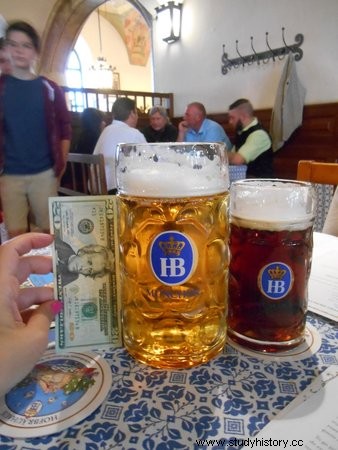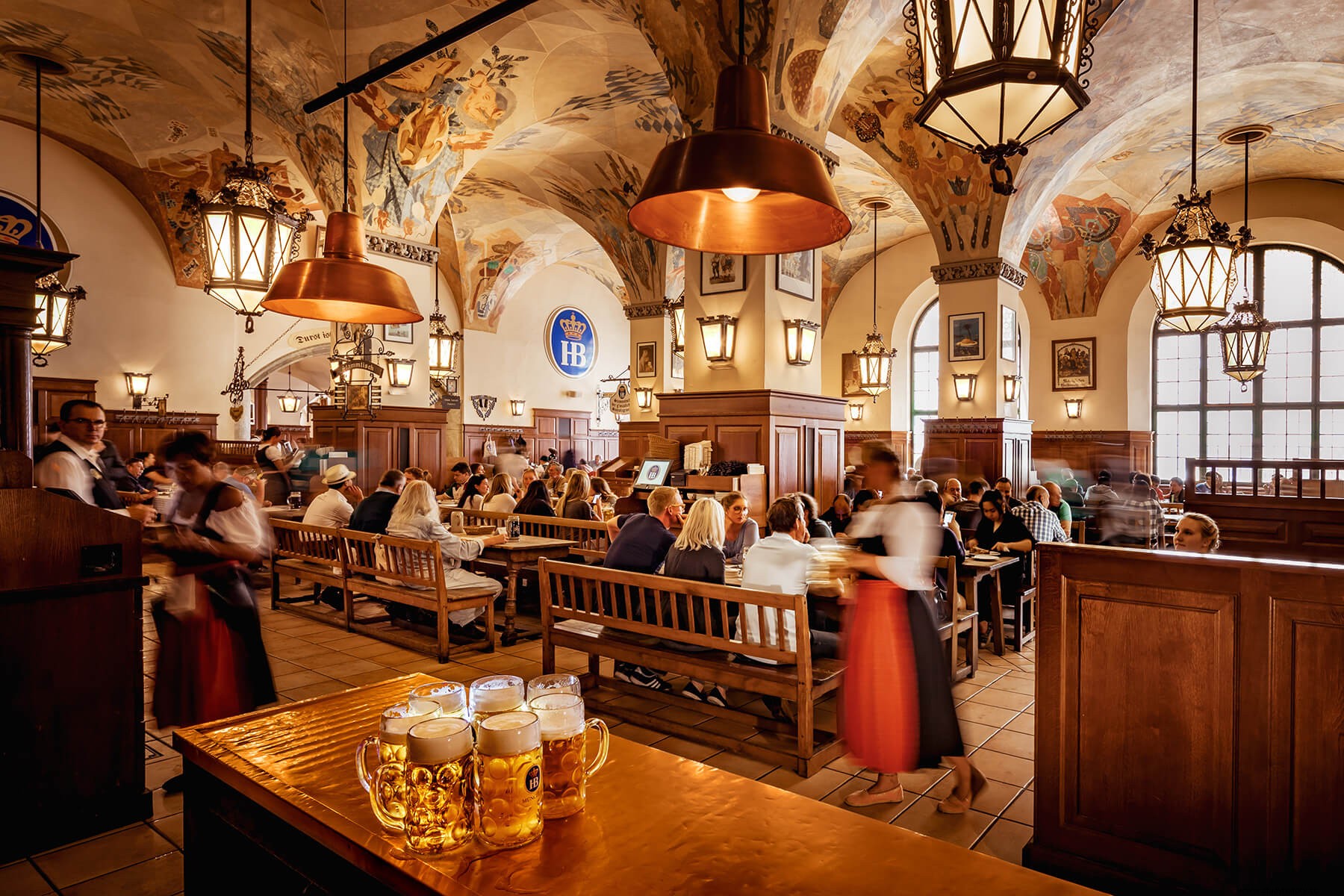
In Munich stands the Hofbräuhaus
One, two, G'Zupfe !
Translation: In Munich stands the Hofbräuhaus
One, two, down the hatch!
Hofbräuhaus songs.
Beer has always been a significant part of German culture. During the Middle Ages and into the Renaissance, water in Europe was beyond polluted. A drink created a number of diseases, such as cholera, typhoid and dysentery. Need, alternative drink The Germans turned to beer. And so Germany's long-standing relationship with the jumping pier was formed.
Bavaria, located in southern Germany, is the beer capital of the country. The capital, Munich, is famous for beer halls. When you take a walk through the city, countless halls or outdoor beer gardens appear. These establishments run the spectrum from a quiet outdoor terrace to a tall, festive room. Regardless of the size of the place, patrons will find a smorgasbord of hoppy brews to choose from.
A sacred hall
The most famous hall in all of Munich, and possibly in the world, is the Hofbräuhaus. Located in the center of Munich, the Hofbräuhaus is a popular tourist destination. Inside the hall, oopmpah bands dressed in traditional Bavarian clothes play festive music for an appreciative (and probably intoxicated) crowd. Munich's Hofbräuhaus has two floors, as well as smaller rooms preferred by celebrities. The Hofbräuhaus also has an outdoor terrace. Protectors sit under chestnut trees while the traditionally dressed waiters and waitresses serve Bavarian food and beer. The beer garden has a relaxed atmosphere compared to the noisy indoors.

The beer is served in solid XNUMX liter mugs, called ein Mass. If it is too much, half a liter of glass is available. In addition to beer, the Hofbräuhaus is equally famous for its food. The menu is packed with Bavarian food:from Rouladen to Weißwurst to Sauerkraut.
The Hofbräuhaus did not achieve its legendary status overnight. The story goes back to 500 years ago. Along the way, the beer hall has had remarkable patrons, both famous and infamous. The Hofbräuhaus has also experienced its share of historical events. This article takes a look at the colorful history of the Hofbräuhaus. The first stop is the number 16
Beginning
The Hofbrauhaus came to life in 1589, but not as a public beer hall. It started as a brewery. At that time, Munich's court community did not like the beer made by local breweries. This forced them to import beer from northern Germany. A popular import area was Einbeck, where the breweries produced an exceptionally strong beer for special occasions. However, not everyone in Munich loved imported beer. The North German beer was expensive; only the rich could afford it.
This situation led Duke Wilhelm V of Bavaria to create his own brewery. Ever since the duke moved to Munich, he wanted to deliver the dish with local beer. September 21, 1589, Wilhelm V opened the ducal court brewery Herzogliches Hofbräuhaus at the old court (called Alter Hof). In a short time, the brewery's brown beer (Braunbier) sold to the public.

However, the desire for strong Einbeck beer remained. In 1612, Einbeck brewmaster Elias Pichler went to Munich to produce "Ainpöckisch Bier". This was abbreviated to "Oanbock", and later to simply Bock. The Hofbräuhaus still brews this beer seasonally. It's called Starkbier (strong beer), and sold in May as "Mailbock".
Purity Law
In 1516, Bavarian nobles made a law stating that only water, barley and hops could be used to brew beer. Named the Purity Act, the nobleman aimed to prevent crops from being wasted on brewing. Legislators also wanted to stop the practice of using cheap ingredients in beer brewing:Unscrupulous breweries used inferior ingredients to make a bigger profit. As a result, beer was often in bad taste and at times toxic. The Purity Act hoped to ensure that only the finest ingredients went to German beer. The penalty for violating the Purity Act was severe. Breweries that used other ingredients had their barrels confiscated without compensation.

The Purity Act remained a permanent fixture in Bavaria for hundreds of years. When Germany united in 1871, Bavaria insisted on the implementation of the Bavarian Purity Act throughout the German state; This was their prerequisite for joining. Bavaria's decision was accepted, and German beer became world famous for its quality and consistency. The Purity Act is long outdated. However, several breweries still follow the law's regulations, more on the basis of the principal and honor than following the law. These brewers want to maintain the high quality of German beer.
Hofbräuhaus og renhetsloven
Munich's Hofbräuhaus played a role in the purity law. By law, wheat beer was banned in Bavaria; wheat was exclusively reserved for bread making. Despite the ban, Duke Maximilian I, heir to Wilhelm V, maintained the right to brew wheat beer (Weißbier). Maximilian preferred the lighter wheat beers instead of the heavy dark beers his predecessor liked.
The duke made the ban a profitable state monopoly. In 1602, Maximilian recruited the first Weißbier master of the Hofbräuhaus. The brewery knocked out the wheat brew and gave the duke a significant profit.
Brewery
Initially, the old court brewery produced brown and white beers. But in five years, production of the popular wheat beer moved to the new White Court brewery (Weißes Hofbräuhaus) on Platzl. The demand for beer became so great that the small brewery of the larger building at the so-called Platzl. The brewery remained there until April 6, 1987 when a fire destroyed the historic building. Today, the brewery is located in Riem, on the outskirts of the city.
Open to the public
In 1612, Maximilian I decided that beer should be marketed to the masses. Beforehand, the wealthy were the primary customers. The dark, strong Mailbock beer was served to the people of Munich. Mailbock also plays a central role in both the Hofbräuhaus and Bavarian history. During the Seven Years' War, Sweden invaded Bavaria. Munich prevented the looting by promising the Scandinavians 1,000 liters of buck. Apparently, this agreement tempted the Swedish forces, and Munich was spared.
Although Maximilian I made beer available to the public, the doors of the Hofbräuhaus were still sealed. This changed in 1828. It was this year that King Ludwig I opened the Hofbräuhaus to the public. The Hofbräuhaus opening set a milestone in German history. It was there that the idea of drinking beer in a place that produced large quantities became a common idea. This is the Hofbräuhaus we know today.
Many more milestones followed. in 1852, the brewery and tavern were taken over by the state of Bavaria. In 1896, the brewery moved to another location. Previously, the brewery and tavern operated out of the same building. Now the building ran only like a beer hall. The building was demolished next year. In the wake of this, a new, larger hall was built, along with an expansive outdoor beer garden. This is the Hofbräuhaus we know today.
Hofbräuhaus -sangen
The growing popularity of the Hofbräuhaus created a song that celebrated the inn. In 1935, Wiga Gabriel and Wilhelm Gebauer composed the song Hofbräuhaus; Gabriel wrote the music and the Gebauer lyrics. An instant hit, notes to the song were quickly sold. The song became a league of Oktoberfest festivities, sung in halls and gardens throughout Germany. Even today, patrons sing the song with the Hofbräuhaus band.
Dark History
While the Hofbräuhaus is celebrated today, the hall has a dark history. In February 1920, the Hofbräuhaus was the site of the very first meeting of Adolf Hitler and the Nationalist Socialist German Workers' Party, also called the Nazi Party. The Hofbräuhaus was no stranger to politics. In 1919, the Munich Communist Party established its headquarters in the hall. However, the policy of the Nazi party was different:it grew to become more ideological and radical.

The Hofbräuhaus is the sight where Hitler gave his infamous "Why We Are Antisemites" speech. This gives the Hofbräuhaus the distinction where Hitler first publicly condemned the Jewish religion. Author Sue Kovach Shuman theorizes the first violent attacks on Jewish people took place at the Hofbräuhaus.
Hitler believed in the Hofbräuhaus played a central role in his and the Nazis' rise to power. That's why the party celebrated its anniversary every year in the beer hall.
WWII and restoration
The Allied bombing of World War II destroyed the Hofbräuhaus rooms. Only one room in the historic beer hall ("Schwemme") survived. After the war was over, work began on building the building. The Hofbräuhaus was one of the first buildings to be built during the post-war restoration. The Hofbräuhaus finally reopened in 1958. At first, business was slow, but an unlikely group saved the Hofbräuhaus. American solidarity stationed in Munich spread the word about the Hofbräuhaus. They marveled at the huge hall and the giant liter mugs. Some even had the heavy mugs with the iconic HB logo.
With the help of US officials, the business of the Hofbräuhaus took over. It was not long before a steady stream of customers entered the newly restored building.
Oktoberfest
Oktoberfest is known all over the world and is an annual festival in Munich. It is held over a two week period and ends the first Sunday in October. The festival began on October 12, to celebrate the marriage of King Louis I (Crown Prince of Bavaria) to Princess Therese von Sachsen-Hildburhausen. The festival lasted for five days, ending with a horse race in an area that was later called Theresienwiese ("Therese's green"). This year's subsequent festivities combined the race with a state agricultural fair. Of the 1818 stalls serving food and drink were added. In the 20's, tents were plentiful. Oktoberfest is now the world's premier holiday celebrating German beer and food.
Hofbräuhaus og Oktoberfest

Of all the Oktoberfest tents, the Hofbräuhaus is still the largest and most famous. Although the famous hall was not always part of the celebration. The Hofbräuhaus first served its beer brand at Oktoberfest in 1950 at the Schottenheml Festhalle. The reasons for this delay in Hofbräu beer at Oktoberfest are doubtful. One reason is a dispute between the owners of the Festhalle and the owners of the Hofbräuhaus. The two parties could not agree on a price for the beer.
To avoid more of these disputes, the Hofbräuhaus set up its own tent in 1952. Since then, the Hofbräuhaus has maintained the tent. When Oktoberfest rolls around, the Hofbräuhaus remains the largest tent. Thousands of teams to drink down all the beer Hofbräuhaus has to offer.
Famous guests
Members of the nobility were the only customers since the audience was barred from the building. A notable patron saint of this period of the brewery was the famous composer Wolfgang Amadeus Mozart. Mozart cited his visit to the Hofbräuhaus as inspiring for his opera Idomeno. Other famous musicians and artists drank Hofbräu beer in the venerable hall, Louis Armstrong and Marcel Duchamp were two examples.
Politicians have raised a glass at the Hofbräuhaus. In the early 20s, Valdimir Ilyich Lenin visited the beer hall. Later, US Presidents John F. Kennedy and George HW entered the Hofbräuhaus atmosphere. Mikhail Gorbachev, the last president of the Soviet Union, is another well-known politician visiting the beer hall.
The long list of famous guests only contributes to the legendary status of the Hofbräuhaus.
Münchens Hofbräuhaus i dag

The mystery surrounding Munich's Hofbräuhaus is still alive today. As you walk into the venerable hall, you will find hundreds of happy people drinking beer, eating good food or singing the song Hofbräuhaus. However, the ongoing Covid-19 pandemic has forced the Hofbräuhaus to close its doors. The once noisy hall is now terribly quiet. This situation is just another part of the Hofbräuhaus' long history.
However, with the gradual distribution of vaccines around the world, it is almost time for the Hofbräuhaus to reopen. Hundreds of locals, tourists and celebrity guests will pack the halls of Munich's Hofbräuhaus.
